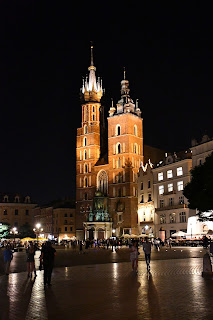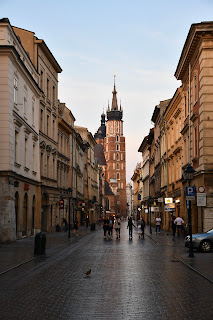A weekend trip to Poland
Not long after returning from Bavaria, my sister and I began to make plans for a weekend trip to Poland. We were joined by her best friend from high school, who, having heard about our successful road trip, was likely not expecting this one to be an utter disaster.
I had
booked tickets for the Auschwitz-Birkenau Memorial and Museum for six o’clock
on Saturday, which was supposed to give us time to stop by a few tourist
attractions on the way. Having been warned about the state of the Czech D1
highway, we left the country via the northern town Náchod, where we spent about
an hour. Náchod is an altogether pleasant town with a nice, relatively sparsely
visited chateau, and a beautiful part-wooden church in the centre. Its bulbous
towers are strangely reminiscent of architectural styles in the east.
We crossed
the border into the tiny spa town Kudowa-Zdrój, exchanging our crowns for złoty
at one of the many little exchange booths along the road. The town was packed,
as some sort of event of Czech-Polish friendship was going on, and the weather
was very pleasant.
Perhaps the
main tourist attraction of Kudowa-Zdrój is its skull chapel – a chapel whose
interior decorations are made of human bones. When we arrived, we joined a
queue outside the building, thinking that the nun in charge was taking a short
afternoon break. Only after about five minutes, as the doors opened and a swarm
of people exited the chapel, did we realise that visitors were being let in in
large groups. After three groups entered and left in this manner, we were
crammed in with several other dozens of people until we were essentially
standing shoulder to shoulder (all the while wearing facemasks, of course, lest
anyone fear this wasn’t the best of ideas). An elderly nun closed the door
behind us and speaking into a microphone with her facemask on, recounted the
history of the chapel in relatively intelligible Polish for a good ten minutes.
I suddenly understood why our friends asked us whether we were visiting Poland
to catch covid.
Feeling
rather uneasy about this escapade, we set our navigation to Oświęcim only to
find that our arrival was suddenly estimated at an hour later than we had expected.
For the longest time, we could not figure out why, but all was explained as we
drove into a massive traffic jam outside Katowice. We learned that the
collection of tolls in Poland is still unautomated, which accounted for the
post-five PM pile-up.
We
arrived past our reserved time and came to the wrong place. What one must
remember when coming to Auschwitz is that there are three parts to the site.
The first is Auschwitz I, which used to be the main camp and currently houses
the museum. It is the location of the “Arbeit macht frei” gate. Tickets are
reserved for Auschwitz I only (as of 2021, they are not required at the other
two sites), and visitors who do not want to join a guided tour are only allowed
to come late in the afternoon (it is better, however, that they reserve tickets
online in advance).
The second part of the site is Auschwitz II-Birkenau, also a
concentration and extermination camp. This is the location of the giant
redbrick gatehouse atop train tracks. There is a watchman at the entrance, but
no tickets are required to enter. The third part is Auschwitz III-Monowitz, a
concentration and labour camp, where the inmates were forced to work in
factories. Not much remains of this last site except for a small memorial by
the road. Tickets are not required here either.
Having arrived at Auschwitz II-Birkenau instead of Auschwitz
I, we toured the massive complex of one-story houses. The part that, at least to
me, was the most illustrative of the inhumane conditions of the camp, was one
of the bathrooms, where the “toilets” (really just holes in slabs) were arranged
side-by-side and opposite each other by the dozens.
There is a bus system that takes visitors from one part of
the site to another, but it was not fast enough to get us to Auschwitz I before
closing time. We visited Auschwitz I again the following morning, but there
were no free spots on the next few English tours, so we at least stopped by the
Monowitz memorial before riding back home.
We arrived in Krakow in the evening, and the city was
shockingly packed. It was like being in a parallel universe where the pandemic
never existed. After leaving our bags at the hotel (which, in contrast to
hotels in Austria, did not require us to present a certificate of vaccination),
we went out amidst the carousing Cracovians, ate dinner, and toured a couple of
sites before going to sleep.
My room, unlike the room my sister and her friend were
staying in, faced the main street, which meant I was constantly being woken up
by drunken celebrations outside. What felt strange to me was that most shouts
were not in foreign languages but in Polish: these were not foreign tourists
trashing the city on their stag nights but its own citizens.
At about four o’clock in the morning, I could not take the
noise anymore and decided to go outside to take pictures. In the early morning
hours, steely taxi drivers were raking in cash from an abundant harvest of
drunks trying to catch a ride home (but still kicking up a huge racket while at
it). I was sad to think of the people living in the city centre who have to put
up with this. Of course, I was a little more interested in the architectural
sights of the city: St. Mary’s Basilica on the main square, St. Florian’s Gate
and the Krakow Barbican up north, and several churches throughout the city
centre. Making my way southwest, I took some pictures of the Wawel Royal Castle
from the banks of the Vistula River and made my way back north along Grodzka
street.
As I mentioned previously, we stopped by the Monowitz
memorial before driving home. Not counting our pitstops, we took two longer
breaks: one in Gliwice and another in Moszna. The first is home to the Gliwice
radio tower. On the 31st of August 1939, a false flag attack on this
building was staged by Nazi Germany as a pretext for its subsequent invasion of
Poland. Nowadays, the radio station stands in the middle of a park with very
few other testaments to the event.
Our second stop was at Moszna Castle which, despite really
being a chateau, is one of the most heavily fortified and inaccessible castles
I’ve ever been to. Its ‘fortifications’ are the roads which lead to it: when they
are not in a woeful state of disrepair, they find themselves in the even more
impractical state of being repaired. But as for the castle itself, it is quite
impressive. That is, I imagine it to be quite impressive when it is not
surrounded by scaffolding.











































































Comments
Post a Comment